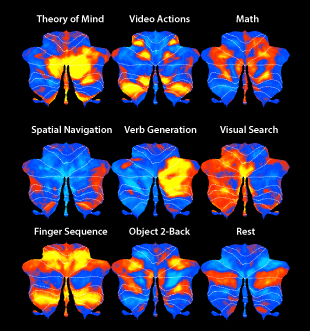After the neocortex, the cerebellum is the largest structure of the human brain. The cerebellar cortex is highly folded and contains more than half of the neurons of the brain. While the cerebellum has been historically thought to be mainly involved in motor control, research over the last 30 years has clearly shown that most of the human cerebellum is dedicated to cognitive functions, such as working memory, cognitive control, action observation, language, and social cognition. In the evolution from simple mammals to humans, the cerebellum has enlarged like no other brain structure (Barton & Vendetti, 2014; Sereno et al., 2020), suggesting a special role in the development of human intelligence. However, what specifically the cerebellum contributes to cognitive function, is still unclear (Diedrichsen et al., 2019).
For the last 18 years, our lab has developed analysis tools to study the human cerebellum using magnetic resonance imaging (MRI). Made publicly available as the SUIT toolbox, these functions allow for the careful anatomical alignment of cerebellar data across participants and provide methods for data analysis and visualization.
 In our current work, we are investigating the functional organisation of the human cerebellum in detail. In multiple studies, we have explored the activity pattern across the spectrum of human mental activity, including language, memory, math, abstract thinking, motor control, mental imagery, motor control, and rest. Using our own multi-domain task battery dataset (King et al. 2019) and dataset of collaborating labs, we have developed functional maps of the human cerebellum that characterize the function of each cerebellar region. We showed that the new maps can be used to predict the functional boundaries in the cerebellum for new tasks and for new participants. Importantly, functional parcellation does not align with the anatomical subdivision of the cerebellum into lobules. The atlases are publically available for download and can be viewed online using our Atlas Viewer .
In our current work, we are investigating the functional organisation of the human cerebellum in detail. In multiple studies, we have explored the activity pattern across the spectrum of human mental activity, including language, memory, math, abstract thinking, motor control, mental imagery, motor control, and rest. Using our own multi-domain task battery dataset (King et al. 2019) and dataset of collaborating labs, we have developed functional maps of the human cerebellum that characterize the function of each cerebellar region. We showed that the new maps can be used to predict the functional boundaries in the cerebellum for new tasks and for new participants. Importantly, functional parcellation does not align with the anatomical subdivision of the cerebellum into lobules. The atlases are publically available for download and can be viewed online using our Atlas Viewer .
It has been long hypothesized that dysfunction of the cerebellum is involved in the development of mental disorders, such as Schizophrenia (Moberget et al., 2018), Autism (Wang et al., 2014) and Dyslexia. More detailed functional maps of the cerebellum will provide a valuable research tool to understand the general function of the cerebellum, and to accelerate insights into the role of the cerebellum in these disorders.
This research is supported by a grant from the CIHR (PJT 159520), the Raynor Cerebellar Initiatives, and the Canada First Research Excellence Fund (BrainsCAN to Western University).
References
- Barton, R. A., & Venditti, C. (2014). Rapid Evolution of the Cerebellum in Humans and Other Great Apes. Current Biology, 24(20), 2440-2444.
-
Diedrichsen, J., King, M., Hernandez-Castillo, C., Sereno, M., & Ivry, R. B. (2019). Universal Transform or Multiple Functionality? Understanding the Contribution of the Human Cerebellum across Task Domains. Neuron, 102(5), 918-928.

-
King, M., Hernandez-Castillo, C. R., Poldrack, R. A., Ivry, R., & Diedrichsen, J. (2019). Functional Boundaries in the Human Cerebellum revealed by a Multi-Domain Task Battery. Nature Neuroscience.

-
Moberget, T., Doan, N. T., Alnaes, D., Kaufmann, T., Cordova-Palomera, A., Lagerberg, T. V., Diedrichsen, J.,...,Westlye, L. T. (2017). Cerebellar volume and cerebellocerebral structural covariance in schizophrenia: a multisite mega-analysis of 983 patients and 1349 healthy controls. Mol Psychiatry, 23(6), 1512-1520.

- Wang, S., Kloth, A. D., & Badura, A. (2014). The Cerebellum, Sensitive Periods, and Autism. Neuron, 83(3), 518-532.